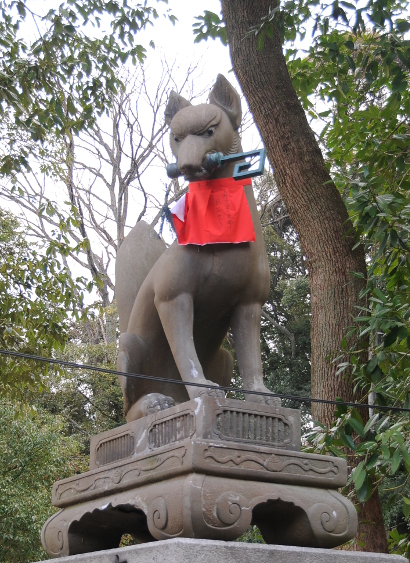Fushimi Inari Taisha is the largest shinto shrine in Japan dedicated to Inari Okami, one of the principal kami or gods of Shinto. Inari is the Japanese god of rice and agriculture as well as industry, and people visit one of the countless Inari shrines to pray for general prosperity and success in business. This is the reason why Inari is vastly popular all over Japan, there are said to be more than 30.000 Inari shrines, that’s more than 1/3 of all the shrines of Japan. The main shrine at Kyoto attracts some 3 million visitors – during the three days of New Year only!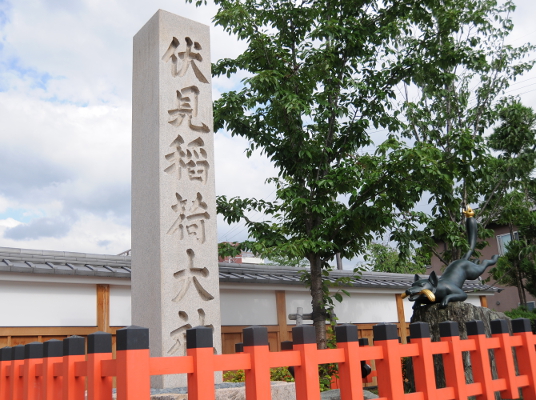 Fushimi Inari Taisha, situated in the south of Kyoto city is the oldest of all Inari shrines. It was allegedly founded in the 8th century – some 100 years before Kyoto became the capital of Japan – by a local family named Hata. Worship of Inari, a local god of agriculture going back to the 5th century, spread quickly however, and around 950 this shrine was chosen to be one of only 22 to receive imperial patronage. In the 15th century, during the Onin wars, the entire shrine complex burnt down, and it took 30 years to rebuild it.
Fushimi Inari Taisha, situated in the south of Kyoto city is the oldest of all Inari shrines. It was allegedly founded in the 8th century – some 100 years before Kyoto became the capital of Japan – by a local family named Hata. Worship of Inari, a local god of agriculture going back to the 5th century, spread quickly however, and around 950 this shrine was chosen to be one of only 22 to receive imperial patronage. In the 15th century, during the Onin wars, the entire shrine complex burnt down, and it took 30 years to rebuild it.
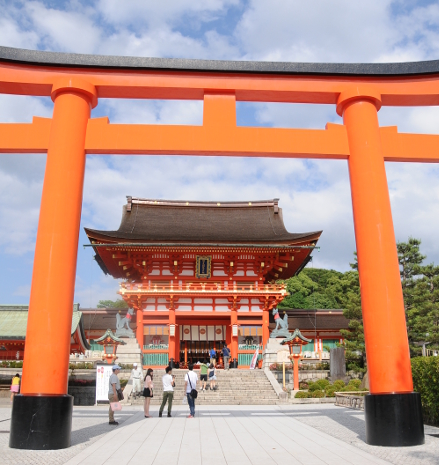 Today, Fushimi Inari Taisha’s main complex is at the foot of Inari hill. There is a beautiful two storey entrance gate, donated to the shrine by Toyotomi Hideyoshi in 1589. Behind it there is the main hall of the shrine, where five different kami – different representations of Inari – are enshrined and can be worshipped.
Today, Fushimi Inari Taisha’s main complex is at the foot of Inari hill. There is a beautiful two storey entrance gate, donated to the shrine by Toyotomi Hideyoshi in 1589. Behind it there is the main hall of the shrine, where five different kami – different representations of Inari – are enshrined and can be worshipped. 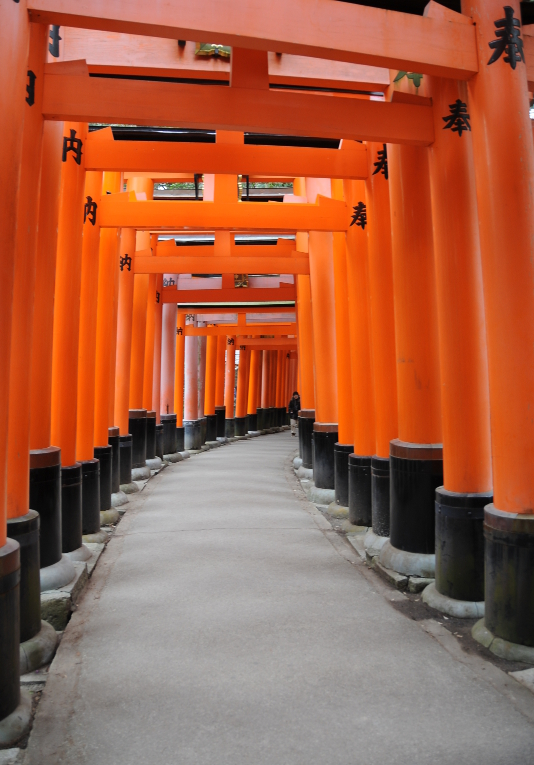
The most interesting and probably best known part of the shrine however, is the hill behind the main structures. Several paths lead up the hill to three more, somewhat smaller shrines where people can worship. The most important one is of course the one on the very top, but the 2 hour hike up there can be strenuous in hot weather, and not all of the worshippers make it, even though there are small restaurants on the way. Additionally, on the higher parts of the hill there are graveyards, which is interesting insofar as Shinto does not usually deal with death – this is the realm of the Buddhists. In olden times however, the distinction between Shinto and Buddhism was blurry, and this is just one of many occasions where it can still be seen today.
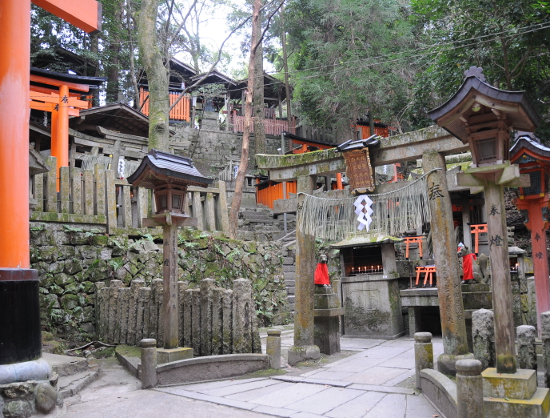 As mentioned above, Inari shrines can be found everywhere and their distinctive feature are their vermillion torii. Whereas other shrines may have only a few, Inari shrines have numerous torii that are often placed behind each other to form a dense archway on the road to the main place of worship. Most of these torii have been presented to the shrine as gift, and at their back, the name of the sponsor (either a personal name or a company) as well as the date of the donation is inscribed in black, which gives a striking image when returning from prayer. Fushimi Inari Taisha, as the main shrine, has some 5000 torii that line the paths up the mountain, all donated by various businesses from all over Japan. Depending on the level on which they are placed and on their size, a torii can be bought for as little as 100.000 YEN, and go up to 4 million YEN or more.
As mentioned above, Inari shrines can be found everywhere and their distinctive feature are their vermillion torii. Whereas other shrines may have only a few, Inari shrines have numerous torii that are often placed behind each other to form a dense archway on the road to the main place of worship. Most of these torii have been presented to the shrine as gift, and at their back, the name of the sponsor (either a personal name or a company) as well as the date of the donation is inscribed in black, which gives a striking image when returning from prayer. Fushimi Inari Taisha, as the main shrine, has some 5000 torii that line the paths up the mountain, all donated by various businesses from all over Japan. Depending on the level on which they are placed and on their size, a torii can be bought for as little as 100.000 YEN, and go up to 4 million YEN or more.  Another characteristic that is unique to Inari shrines is the fox. Lots of statues of foxes can be found there, in various sizes and finish, from tiny ceramic foxes to huge stone ones. They can also be bought as lucky charms. The image below shows a fox statue with a key in its mouth – the key is supposed to be one to a granary. Although in ancient Japan foxes did the job of hunting mice – hence the granary reference – they still have a somewhat ambiguous image. Since they can transform into a human being, foxes are seen as mischievous and sometimes dangerous. They are also believed to be Inari’s messenger, and if you treat a fox well, you will be rewarded by the god. But beware if you are cruel to a fox, punishment will be swift!
Another characteristic that is unique to Inari shrines is the fox. Lots of statues of foxes can be found there, in various sizes and finish, from tiny ceramic foxes to huge stone ones. They can also be bought as lucky charms. The image below shows a fox statue with a key in its mouth – the key is supposed to be one to a granary. Although in ancient Japan foxes did the job of hunting mice – hence the granary reference – they still have a somewhat ambiguous image. Since they can transform into a human being, foxes are seen as mischievous and sometimes dangerous. They are also believed to be Inari’s messenger, and if you treat a fox well, you will be rewarded by the god. But beware if you are cruel to a fox, punishment will be swift!